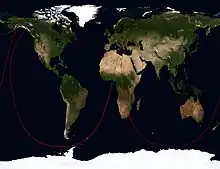| Manufacturer | TsNII Kometa NPO Lavochkin |
|---|---|
| Country of origin | Soviet Union Russia |
| Applications | Early warning of missile attack |
| Specifications | |
| Regime | Molniya |
| Production | |
| Status | Inoperable |
| Built | 86+ |
| Launched | 85 |
| Operational | 2 |
| Lost | 6 |
| Maiden launch | Kosmos 775 8 October 1975 |
| Last launch | Kosmos 2469 30 August 2010 |
Upravlyaemy Sputnik Kontinentalny (Russian: Управляемый Спутник Континентальный meaning Continental Controllable Satellite) or US-K (Russian: УС-К) is a series of Russian, previously Soviet, satellites used to detect missile launches as part of the Oko system.[1] It consists of a constellation of satellites, usually in molniya orbits, designated under the Kosmos system. The satellites are built by the company NPO Lavochkin and are launched on Molniya-M rockets. Oko can be directly translated as the Russian word for eye. As of June 2014, only two of the eight satellites in orbit were still functional, rendering the system inoperable.[2]
History
US-K are the first generation of Oko satellites, the first of which was launched in 1972. The vast majority of the satellites launched (86 out of 100 as of March 2012 [3]) have been US-K satellites in molniya orbits. Seven first generation satellites were launched into geosynchronous orbits, called US-KS, starting in 1975.[4] A decree of 3 September 1979 led to the creation of the second generation satellites US-KMO which had their first launch in 1991.[5] In total, 101 satellites have been launched.
After the dissolution of the Soviet Union, the rate of launches decreased, but Russia remained committed to the programme. A fully functioning constellation with 5 satellites was restored in 2001, but a fire in May 2001 in the Oko control facility at Serpukhov-15 near Kurilovo outside Moscow reduced the number of operational satellites to 2.[6] A further satellite was launched in the same year. Between 2002 and 2006, there were no Oko launches, until another Oko satellite, designated Kosmos 2422, was launched in July 2006.[7]
In 2006, Russia had one operational US-KMO (Kosmos 2379) satellite and four US-K satellites (Kosmos 2422, Kosmos 2393, Kosmos 2351, Kosmos 2368).[7] In June 2011, Kosmos 2422, Kosmos 2430, Kosmos 2446 and Kosmos 2469 were reported to be the only operational satellites.

Satellites
The Oko satellites are drum-shaped, 2 metres long and with a diameter of 1.7 m. They weigh 1,250 kilograms without fuel and 2,400 kilograms when fully loaded. They have a 350 kg infrared telescope pointing toward Earth, with a 4 m conical sunshield and an instrument bus. The telescope, which is the satellites' main instrument, is able to detect radiation from ascending missiles. Two solar panels provide a total of 2.8 kW of power. There are also several smaller, wider-angle telescopes to supplement the main instrument. The satellites have 16 liquid fuel engines for attitude control and 4 for maneuvering.[7]
The system requires at least 4 satellites to be fully functional. The danger of false alarms increases when there are fewer than 4 satellites in orbit, due to the inability to double-check a detection.[7] However, this risk is reduced by the presence of the US-KMO geosynchronous satellites.
The satellites are built by NPO Lavochkin and launched with Molniya-M rockets. The advantages of Oko include that the system is reliable and well-established, and that it uses the relatively inexpensive (but now discontinued) Molniya launcher.[7]
The last US-K satellite (Kosmos 2469) was launched on 30 September 2010.[8] As of December 2015, the entire Oko programme is being replaced by the new EKS system.[9]
References
- ↑ Forden, Geoffrey (May 3, 2001). "Reducing a Common Danger: Improving Russia's Early-Warning System" (PDF). Cato Policy Analysis No. 399. Cato Institute. Archived (PDF) from the original on October 10, 2012. Retrieved May 5, 2012.
- ↑ "Russia blinded by loss of missile detection satellite". Moscow Times. 26 June 2014. Archived from the original on 30 December 2018. Retrieved 22 May 2018.
- ↑ Krebs, Gunter. "US-K (73D6)". Gunter's Space Page. Archived from the original on 11 May 2013. Retrieved 5 March 2012.
- ↑ Krebs, Gunter. "US-KS (74Kh6)". Gunter's Space Page. Archived from the original on 17 January 2012. Retrieved 5 March 2012.
- ↑ Podvig, Pavel (2002). "History and the Current Status of the Russian Early-Warning System" (PDF). Science and Global Security. 10 (1): 21–60. Bibcode:2002S&GS...10...21P. CiteSeerX 10.1.1.692.6127. doi:10.1080/08929880212328. ISSN 0892-9882. S2CID 122901563. Archived from the original (PDF) on 2012-03-15.
- ↑ Topol, Sergey; Safranov, Ivan (11 May 2001). "У России проблемы с ПРО: Она сгорела" [Russia has an ABM problem: it burnt down]. Kommersant. Archived from the original on 2014-10-20. Retrieved 2012-04-23.
- 1 2 3 4 5 Harvey, Brian (2007). "Military programs". The Rebirth of the Russian Space Program (1st ed.). Germany: Springer. ISBN 978-0-387-71354-0.
- ↑ Pavel, Podvig (2010-09-30). "Cosmos-2469 might be the last HEO early-warning satellite". Russian Strategic Nuclear Forces. Archived from the original on 2012-03-09. Retrieved 2012-04-22.
- ↑ "Soyuz 2-1B launches EKS-1 to upgrade Russian Early Warning System". 17 November 2015. Archived from the original on 2015-12-20. Retrieved 2015-12-17.